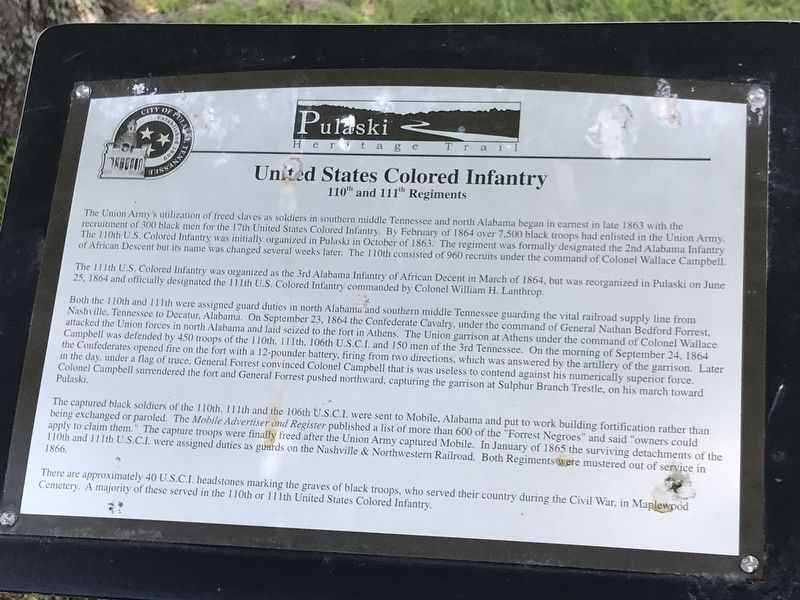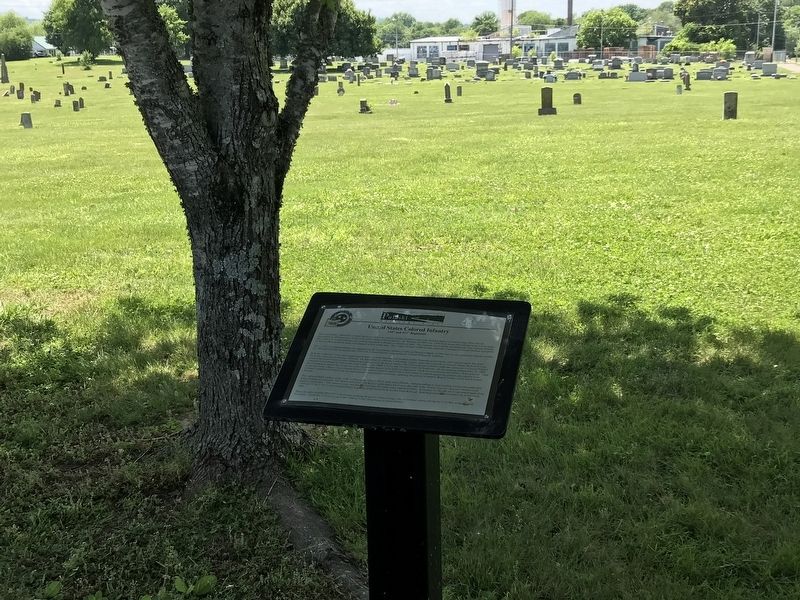Pulaski in Giles County, Tennessee — The American South (East South Central)
United States Colored Infantry
110th and 111th Regiments
The 111th U.S. Colored Infantry was organized as the 3rd Alabama Infantry of African Descent in March of 1864, but was reorganized in Pulaski on June 25, 1864 and officially designated the 111th U.S. Colored Infantry commanded by Colonel William H. Lanthrop.
Both the 110th and 111th were assigned guard duties in north Alabama and southern middle Tennessee guarding the vital railroad supply line from Nashville, Tennessee to Decatur, Alabama. On September 23, 1864 the Confederate Cavalry, under the command of General Nathan Bedford Forrest, attacked the Union forces in north Alabama and laid seized to the fort in Athens. The Union garrison at Athens under the command of Colonel Wallace Campbell was defended by 450 troops of the 110th, 111th, 106th U.S.C.I. and 150 men of the 3rd Tennessee. On the morning of September 24, 1864 the Confederates opened fire on the fort with a 12-pounder battery, firing from two directions, which was answered by the artillery of the garrison. Later in the day, under a flag of truce, General Forrest convinced Colonel Campbell that is was useless to contend against his numerically superior force. Colonel Campbell surrendered the fort and General Forrest pushed northward, capturing the garrison at Sulphur Branch Trestle, on his march toward Pulaski.
The captured black soldiers of the 110th, 111th and the 106th U.S.C.I. were sent to Mobile, Alabama and put to work building fortification rather than being exchanged or paroled. The Mobile Advertiser and Register published a list of more than 600 of the “Forrest Negroes” and said “owners could apply to claim them.” The capture troops were finally freed after the Union Army captured Mobile. In January of 1865 the surviving detachments of the 110th and 111th U.S.C.I. were assigned duties as guards on the Nashville & Northwestern Railroad. Both Regiments were mustered out of service in 1866.
There are approximately 40 U.S.C.I. headstones marking the graves of black troops, who served their country during the Civil War, in Maplewood Cemetery. A majority of these served in the 110th or 111th United States Colored Infantry.
Erected by City of Pulaski.
Topics. This historical marker is listed in these topic lists: African Americans • Cemeteries & Burial Sites • War, US Civil. A significant historical year for this entry is 1863.
Location. 35° 11.502′ N, 87° 1.658′ W. Marker is in Pulaski, Tennessee, in Giles County. Marker is on South Sam Davis Avenue south of Cleveland Street, on the right when traveling south. Marker is in Maplewood Cemetery. Touch for map. Marker is at or near this postal address: 500 Ballentine St, Pulaski TN 38478, United States of America. Touch for directions.
Other nearby markers. At least 8 other markers are within walking distance of this marker. Pulaski Cornerstone — Southeast (a few steps from this marker); Professor John Thomas Bridgeforth (within shouting distance of this marker); Dr. William Albert Lewis (within shouting distance of this marker); Samuel “Sam” Davis (within shouting distance of this marker); James M. McCallum (about 300 feet away, measured in a direct line); John Goff Ballentine (about 300 feet away); Maplewood Cemetery (about 600 feet away); Thomas McKissack Jones (about 600 feet away). Touch for a list and map of all markers in Pulaski.
Also see . . .
1. Battle Unit Details — 110th Regiment, United States Colored Infantry. History of the unit, with link to the Civil War Soldiers and Sailors System's entries on the unit's members. From National Park Service. (Submitted on June 9, 2020, by Duane and Tracy Marsteller of Murfreesboro, Tennessee.)
2. Battle Unit Details — 111th Regiment, United States Colored Infantry. History of the unit, with link to the Civil War Soldiers and Sailors System's entries on the unit's members. From National Park Service. (Submitted on June 9, 2020, by Duane and Tracy Marsteller of Murfreesboro, Tennessee.)
Credits. This page was last revised on June 10, 2020. It was originally submitted on June 9, 2020, by Duane and Tracy Marsteller of Murfreesboro, Tennessee. This page has been viewed 333 times since then and 47 times this year. Photos: 1, 2. submitted on June 9, 2020, by Duane and Tracy Marsteller of Murfreesboro, Tennessee. • Bernard Fisher was the editor who published this page.

